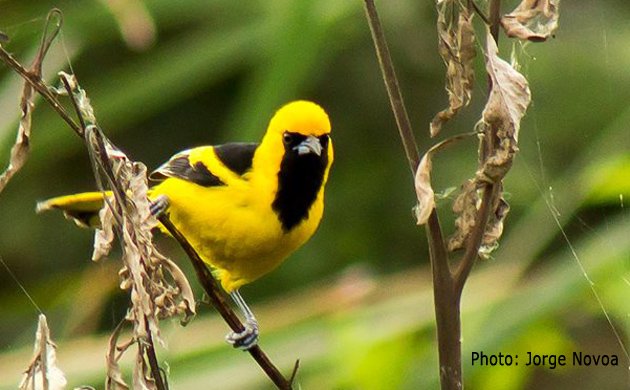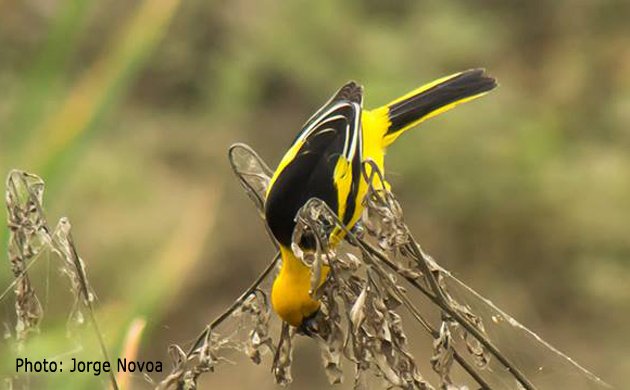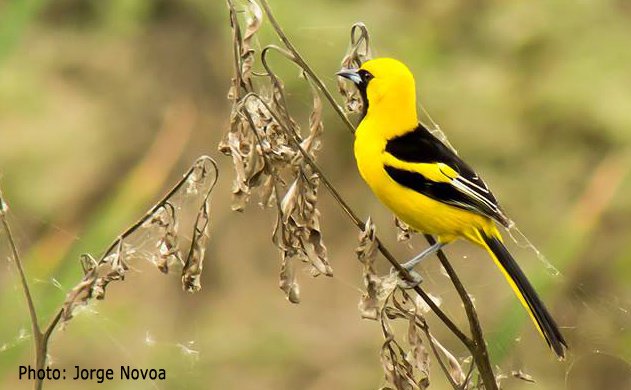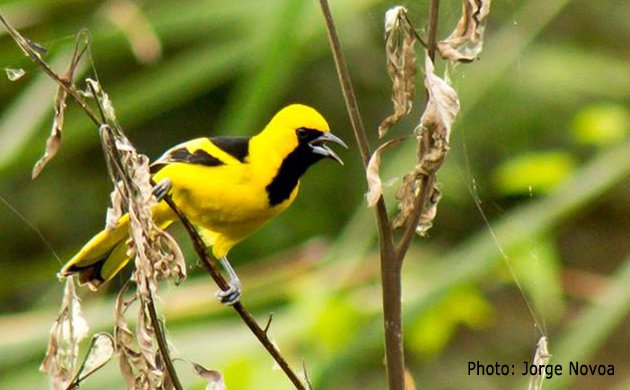
Digital photos or illustrations for a bird field guide? This is perhaps one of those arguments where about half the people like one way and the other half the other.
I am tackling a small project to produce a short bird identification guide with the most common species at a single site. The guide needs to include only a few species, but it should be comprehensive enough so that users are able to identify birds in their male, female, and juvenile plumage.

Yellow-tailed Oriole showing multiple positions. Series of photos by Jorge Novoa
A quick internet search for information on this yielded more than what I was expecting. I also ran this question by a few non-birding naturalists I know. Well, it appears that just about everyone has a reason to like one way or the other. As an exercise intended to help me make a decision, I summarized the reasons people cited to favor illustrations and digital photos of birds.
Reasons to favor illustrations:
- Illustration can portray a bird in positions that lead the user towards relevant identification details, which can even be exaggerated and pointed out.
- Illustrations allow for detailed differences in plumage variation among different sexes, age, molt, and breeding stages.
- Illustrations can use the same position of a bird to compare variation within species and between similar species.
- Good photos for of all the different ages, sexes, morphs, and seasonal variants can be difficult to obtain.
- Photos always have the variability of the light in which they were taken. Such lighting differences can lead to color variation.
- Unlike illustrations, the background in photos of birds distracts the user from focusing on relevant field marks.
- There is no photo guide that has consistently good photos
- Illustrations are easier to look at.
Reasons to favor digital photos of wild birds:
- No illustration comes even close to a good photograph of a bird.
- Illustrations fail to capture the jizz of a bird.
- There is so much variability among illustrator skills. Some illustrations add to the confusion rather than helping with identification.
- Photos can be edited and doctored to correct for unusual light and color variation and make them resemble the color an observer would expect to see in the field.
- With so many people taking photos of birds these days, photos can easily be assembled to display the range of variation.
- It would be too much to ask of an illustrator to paint many depictions of the same species

Yellow-tailed Oriole. Photo: Jorge Novoa
It appears everyone has personal reasons to favor one way or the other. These reasons may have to do with what we have grown accustomed to. For instance, for many of us field guides that use illustrations is all we know. Changes to a new way to see birds in field guide can be difficult or just undesired particularly when some truly amazing field guides using illustrations are available to us.

Yellow-tailed Oriole. Photo: Jorge Novoa
Changes are perhaps in the horizon. With the advent of the digital revolution and the ease to obtain camera equipment, more and more good quality bird photos are becoming available. Two great bird books using photos are gaining more and more popularity. Perhaps over time, this is the route of the future, or perhaps as some suggested, one would want to have both; field guides that use photos and field guides that use illustrations and use them both alternatively. As for the folks that like fish, corals, and butterflies (non-birding naturalists), photographic guides is mostly what they know and could not imagine a field guide that use illustrations.
As for my project, all of these points are valid and are being considered. But this being a low budget project, the cost of hiring an illustrator for this job may be the straw that tilts the scale towards using photos of birds.













If only I could draw!
A good photograph can capture the spirit of a bird like few drawings can, but an illustration can pinpoint the characteristic features needed for a correct identification.
I wish I could draw!
Generally speaking, I like to have an illustrated guide as my all-purpose field guide (like Sibley for North America), but I’m okay with photos for more specialized guides, like for bird families or local birds. With difficult species I often find myself looking first through my illustrated guides, and then turning to a photo guide or two for additional examples of the species I’m considering.
The absolute best is to have both. Apps which have drawings do what you have pointed out, but the photos round out the bird and are more like what you see in the field. The combination is invaluable when you are in a different continent with totally new and different families I found earlier in the year.
It its interesting that people like illustrations because they don’t have “distracting” backgrounds. That makes no sense though, birds seen while birding will always have a background that may distract from some field markings. Better to learn how to see the bird in its natural setting!
Has anyone ever done a fieldguide with both illustrations and photos? Perhaps that would be the best of both worlds. Getting a photo that captures the typical individual of the species in just the right light and position, showing a typical posture is very hard. Sometimes an illustration can show that better or at least is easier to get than the perfect photo. Maybe a combination of both ways could work.
One or two good illustrations are almost certainly going to be more useful than one or two good photos. For big field guides that cover a lot of species, a few well-done illustrations can capture the most important ID points better than a photo.
As the numbers go up, though, photos become more useful. If your book is an in depth look at a relatively small number of species, then using multiple photos can show the birds in a range of light, habitat, behavior, age/sex variation, etc that can be hard to capture in an illustration.
A good example would be the Obrien/Crossley/Karlson Shorebird Guide. Great use of many photos of each species to really give a reasonably complete picture of what that species might look like in the field.